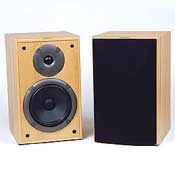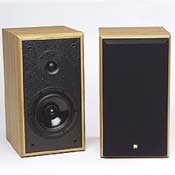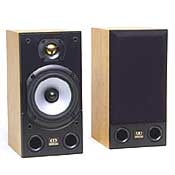Battle of The Bookshelfs Page 3
DR: The Boston Acoustics CR75's slight upper-midrange/ lower-treble boost, at least relative to the Jamo and the KEF, gave it a forwardness and clarity missing from the others, especially in loud and complex textures. The boost also contributed to an excellent sense of spatiality that benefited choral and orchestral music. At times, however, the Bos ton speaker's tonal balance gave a slight steel iness to the massed strings in the Copland and Stravinsky ballets, and the Mozart and Bizet operas, plus a twinge of sibilance to vocals. Played very loud, it could turn harsh in timbre, an impression abetted by its slightly less full upper-bass response compared with the Jamo and KEF. It overloaded, but not severely, on the bass drum in Stravinsky's Rite of Spring. 
| Jamo E 610 | A.G. | D.R. |
| Tonal Balance | 4 | 4 |
| Dynamics | 4 | 4 |
| Bass | 4 | 4 |
| Imaging | 5 | 3 |
AG: The first two cuts I listened to on the Jamo E 610 were jazz selections. Right away, I knew that I'd found an appropriate speaker for this kind of music. Its slightly laid-back high end took the edge off the aggressive sax solos on the Charlie Hunter Trio selection, while its punchy, very low-reaching bass helped to convey the drum kit's tremendous energy and drive. While I found this top-end reticence somewhat less engaging on pop songs like the Beth Orton track, the overall tonal balance struck me as very good, with excellent results on vocal recordings and midrange-focused instrumentals like the Charles Lloyd track.
The Jamo also excelled at imaging. The stereo spread cast by the speakers seemed boundless - the ambient scratches and clicks on the Massive Attack track seemed to come from hundreds of feet away. And when this same track erupted into all-out rock mode toward the end, the Jamo showed itself capable of wide dynamics, effortlessly conveying the slamming drum kit and roaring guitars. The Jamo proved to be a standout speaker in virtually every parameter. Though its slightly dark sound caused it to trail behind the Monitor Audio Bronze 1 in the bake off, I'd be happy to own a pair of Jamo E 610s.
DR: The Jamo's tonal balance produced a slightly recessed orchestral image, especially compared with the Boston Acous tics. It was also slightly less clear than the Boston in the complex textures of The Rite of Spring as well as the Run Lola Run sound track. On my homemade recording of an a cappella doo-wop quintet, the Ja mo's tonal balance was a tad less accurate than the Boston's. However, its superior bass performance - evident on the Stravinsky and the Bach organ music - helped its dynamics score. While I caught a hint of an undue resonance on one operatic vocal, in general vocals came out accurately. The E 610 came in a close second to the Boston in its three-way comparison, which was almost a tossup even though they sounded quite different.

| KEF Cresta 2 | A.G. | D.R. |
| Tonal Balance | 2 | 2 |
| Dynamics | 2 | 2 |
| Bass | 1 | 1 |
| Imaging | 3 | 3 |
AG: You can tell a lot about a speaker by focusing on how it handles cymbals. Unfortunately for the KEF Cresta 2, the prominent cymbal scrapes on the Charles Lloyd cut sounded thin and pretty much devoid of complex overtones and air. Things might have balanced out a bit if the Cresta 2 had been capable of as much bass as the Boston Acoustics CR75. But its low end was fairly anemic, kicking in only enough to help muddy the midrange. As for tonal balance, the KEF was my least favorite speaker in its group of three.
While it didn't score badly on imaging, it was hardly a standout. The KEF managed to deliver the spaciousness of the Goldfrapp mix and ably handled the wide stereo spread in Massive Attack. But its overall presentation was flat, and its dynamics were often compressed. This was most obvious during the hard-driving conclusion to the Massive Attack cut. The mix sounded hard and indistinct during the cres cendos, and the speaker's already thin bass became even more deficient.
DR: Whatever other merits this model may have, they were hard to hear through its decidedly muffled and colored sound. This was immediately evident on the very first track I played (the Mozart opera) and was impossible to ignore as I continued listening. The somewhat nasal coloration made it difficult to understand the lyrics and spoken dialogue in the operas and produced a somewhat congested sense of space. Playing the KEF loud further emphasized the tonal misbalance, and its woofer was the first of its group to overload on The Rite of Spring's bass-drum whacks. The background noise on several recordings, which was unduly emphasized by the KEF Cresta 2 when it was played loud, also sounded colored (this is a useful test, since the ear's sensitivity to tonal values changes with volume level). 
| Monitor Audio Bronze 1 | A.G. | D.R. |
| Tonal Balance | 5 | 4 |
| Dynamics | 4 | 4 |
| Bass | 5 | 4 |
| Imaging | 5 | 4 |
AG: The Monitor Audio's most obvious qualities were its wide dynamics and ear-pleasing tonal balance. The sax solos on the Charlie Hunter track sounded effortless, and there was a tremendous sense of energy and momentum when the drums build up in intensity toward the end. The Bronze 1 had the second-deepest bass of all six speakers, transmitting full, tight, and well-defined lows. The bowed bass strings on the Beth Orton track came across as clean and powerful. The highs on this cut were nicely detailed, with the high-hat cymbals and snare drum sounding crisp but not at all fatiguing.
The midrange performance was magical. The Monitor Audio sounded best on the Goldfrapp cut's breathy, close-miked female vocals and the piano solo on the Charles Lloyd, both of which were appealingly smooth and liquid. Imaging was also good, with the panorama of the Massive At tack mix coming across with impressive width and depth.
DR: Aside from having, by a slight margin, the best bass performance of the six speakers, the Bronze 1 did a better job than the Acoustic Energy and NHT of clearly reproducing complex orchestral textures. It also gave an excellent sense of space in cathedral choir music (Descants from Trinity, Conifer). While the string sound could be a touch harsh and steely if played very loud, vocals on cuts like my homemade recording of a doo-wop quintet came out sounding very natural. The Monitor Audio produced the best sound of its comparison trio playing both loud techno music (Run Lola Run) and even disco (the soundtrack from Saturday Night Fever).
- Log in or register to post comments




















































